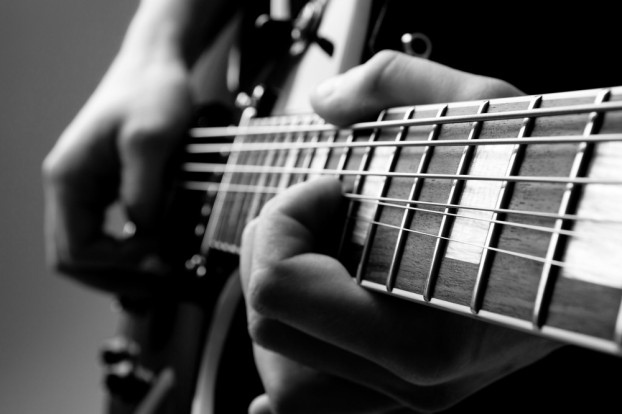If you’ve decided to begin playing a musical instrument, then you’ve completed step one. Unfortunately, step two may require a little more thought—now you need to decide which instrument to pursue. The prospect of narrowing the field down to one instrument can seem like a daunting task, how will you know if you’re making the right choice? Should you try woodwinds, brass, strings or rhythm, and once you make the choice, how will you begin to learn? In the end, the key to selecting the right instrument for you, is to consider the instrument in its entirety.

Guitarist – Shutterstock
Some things to consider before making the purchase include:
- The cost of the instrument (including upkeep)
- The space needed to store the instrument
- The noise level produced
- How much commitment is required to learn?
- Will you require professional lessons?
Of course, despite all of this, you want to pick an instrument based on what you love. If you are passionate about rock and roll, the electric guitar or drums are good options, but if you enjoy classical, you may be itching to pick up the violin or flute. Ultimately, if you go for an instrument that really resonates with you, the odds of you sticking with that instrument will be greater.
If you are a jazz lover, you may want to give the saxophone a shot (either alto or tenor). The saxophone:
- Will cost you $750-11,000 to purchase
- Is relatively easy to learn, but it can take you a lifetime to perfect your own unique sound
- Will need replacement reeds and pads
- Weighs about 5 pounds and doesn’t take up too much space
- Can’t be muted, so it can be loud
A fan of classical music may be drawn to the violin for its beautiful and delicate sound. However, this sound can be quite difficult to master. The Violin:
- Will cost you $500 to $250,000 at a professional level
- Can be muted with a regular mute or a practice mute to soften the sound
- Will need replacement strings and a bow (which can also be pricy)
- Is difficult to play
- Easy to store
One of the most popular instruments to learn is the piano and you may even be one of the many children whose parents put them in lessons at a young age. The piano:
- Will cost you $4000-75,000 (of course you can always purchase an inexpensive keyboard to start)
- Can be muted with a mute pedal or closed lid
- Will take up space in the home
- Will need to be regularly tuned, most likely by a professional
A guitar is a practical instrument to choose for they can be relatively inexpensive and easy to transport. A guitar:
- Will cost you $200-10,000
- Can’t be muted, although acoustic versions aren’t too loud
- Will need replacement strings
- Can easily accompany different musicians
- Won’t take up much room
- Will make your fingers sore during the learning process
Once you’ve made your selection, it’s time to start learning to play. If you are diligent and self-motivated, it’s entirely possible to learn on your own, but if you’d like the added motivation, professional lessons are a good idea (especially when dealing with a more difficult instrument like the violin).
But if you don’t feel like spending more money on lessons, there are now many apps available for smart phones and tablets that can help you along as you begin learning your new instrument. Karajan is an app that will provide you with lessons on how to recognize scales, chords, intervals and pitch, while you play along on a simulated piano or guitar. Guitar Lab is an app that will stream guitar lessons to your iPad and Piano Man will help you to learn piano and practice timing. And if you don’t own a smart phone or tablet, there is always trusty old YouTube. If you are ready to begin learning a musical instrument, but aren’t prepared to purchase a brand new model, think of picking up an instrument at a pawn shop.
Swing by www.ezcashcolumbus.com and browse through the selection of Columbus Ohio musical instruments. EZ cash pawn shops buy and sell instruments constantly so their customers can find quality instruments at excellent prices. Let the music commence.